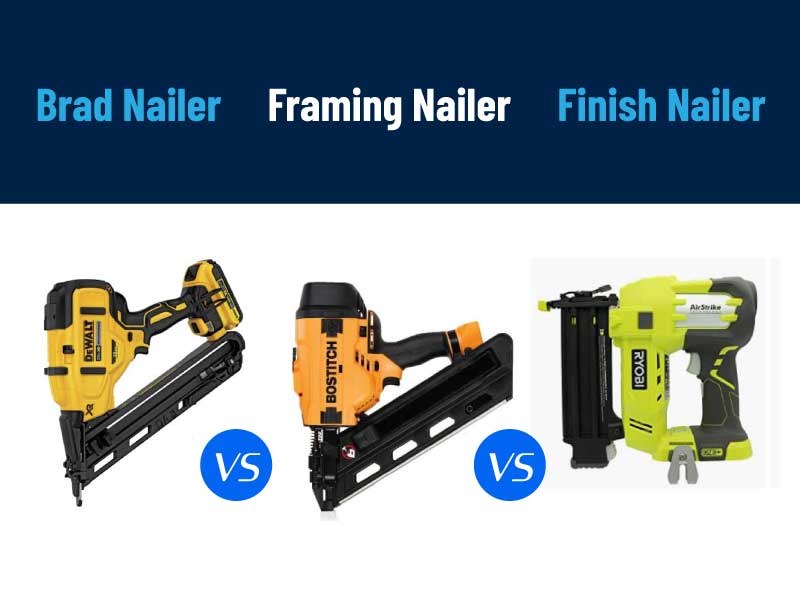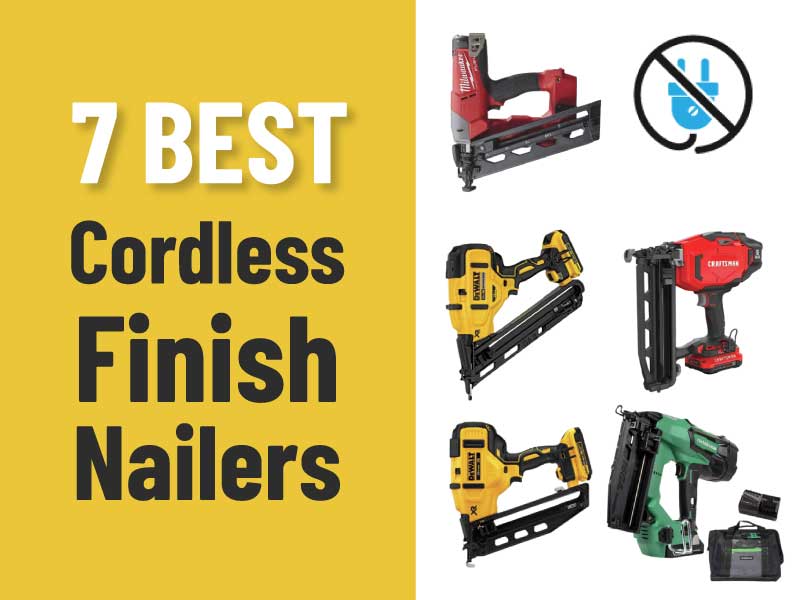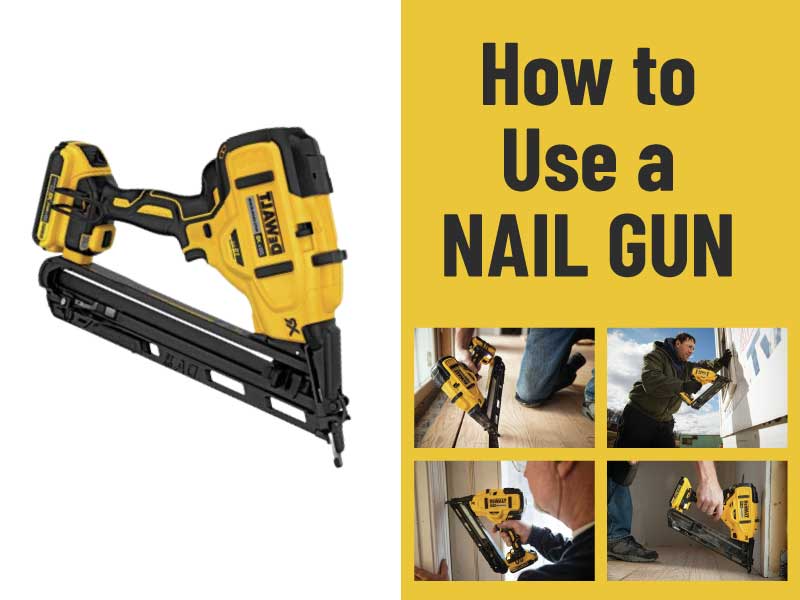It is really a tough task for people, especially if they are beginners, to make out what sort of nail gun they must use to complete different jobs. This is why we are here to help you figure out the ideal nail gun for each type of task. In this article, you will get to know the difference between the very common types of nail guns. Know in detail about Brad nailer vs. framing nailer vs. finish nailer along with their job suitability. So, without any further delay, let’s dig into the nails deeper.
How Are The Nail Sizes Get Measured?
The size of the nail gauge indicates the diameter or thickness of a nail. If the gauge of the nail is lower, the nails will be thinner and vice-versa. Another element of the nail gauge is the length of the nails which is measurable in inches.
The most common sizes of nails start from 14 gauges to 16 gauges and 18 gauges. This figure is a representation of the number of nails that includes an inch. An 18 gauge brad nail consists of 18 nails in every inch. Besides, an 18 gauge ⅝ inch nail represents a nail of 18 gauge with ⅝ inch of length.
In addition, the framing nailers add the degree. The angle of the magazine and the kind of task determines the use of angled nails.
What is a Brad Nailer?
A brad nailer is equipment used for shooting only 18-gauge brad nails to nail. Hence, the name brad nailer came from its function.
Brad specifies the thinner nails that vary from 18-gauge or 24-gauge. Because of possessing a thin nail, it enjoys the advantage of making a tiny hole in the surface of the task.
As the holes are tiny, they go almost unnoticed without leaving a mark on the surface of the task. As a result, there is no need for using putty on the work surface to conceal the holes.
Moreover, a smaller brad nailer prevents splitting the woods during the nailing job. So, a smaller diameter brad nailer is suitable for use in works that need precision.
Regardless, an 18-gauge nail cannot be used in every work as they are not strong enough to carry heavy duties. It is primarily suitable for use on thin surfaces of wood that need precise work finishing.

Pros
- Ensures accurate and precise finishing
- Prevents splitting of wood
- Easy to remove nails when not required
- Requires no putty to hide hole marks
Cons
- Not suitable for working on thick or hardwood
- Not suitable to nail hard to reach nooks and compact spaces
What Is A Framing Nailer?
Unlike brad nailers, a framing nailer is powerful equipment designed to work on large projects. This heavy-duty, powerful equipment is best suitable for use in projects that employ several large nails to nail into thick and hard materials.
For example, these nailers are mostly used by professionals on house building projects. Building a home from scratch or expanding the house requires heavy-duty framing nailers. Similarly, framing nailers are also essential to building a deck.
Generally, framing nail guns use nails ranging from 1-¼ inches to about 3-½ inches. It possesses sufficient capacity to unite 2x 4s fences. Also, it is best to work on nailing plasters without making a crack.
The framing nailers are quite different from the other two nail guns. The framing nailer magazines consist of various angles such as 21 degrees, 28 degrees, and more. The nailer gives support to nails corresponding only to that angle.
Nonetheless, some hybrid nailers support various angled nails. Besides, in terms of the head, the framing nailers are of two types- rounded head and clipped head.
But, there is no consensus as to which one is better. On the one hand, a clipped head nailer can hold more nails than a round head nailer. On the other hand, some specific building codes avoid clipped-headed nails. So, both heads have some positive and negative qualities.
Pros
- Variation in the size of the nails offers great flexibility in work
- Nails are hard and durable
- Ideal for holding heavy-weight things
- Suitable for use in compact spaces with efficiency and accuracy
Cons
- Sometimes, varied framing nailer requires different angled shots.
What Is A Finish Nailer?
Like the other two nailers, the name of the finish nailer can hint at its use. A finish nailer is hard power equipment designed to shoot nails for finishing projects like paneling, molding, and installing trims. Unlike framing nailers, a finish nailer is not practical for serving heavy-duty or bulk jobs.
Accordingly, finishing nail guns use tiny nails that typically vary between 15-gauge and 16-gauge nails that can hold heavy tasks. That means they use thicker nails than the brad nailers. Based on the type of work, finish nailers hold 1 to 2 ½ inch nails.
Though woodworkers generally use brad nailers, there are a few specific cases where they prefer using finish nailers. Finishing nailers can easily penetrate thick woods.
Furthermore, finish nailers can be categorized into two types based on their shoot. The first one is for straight-shooting, and the second one is for angled shooting. There are different sorts of angled nails for various nailers.
Hence, it becomes easier to shoot nails in tight and compact places. The finish nailer nails possess different angles, gauges, depth sizes, and materials. Therefore, sometimes it becomes difficult to determine the perfect finish nailer for a specific task.
Pros
- Able to hold thicker and harder wood
- 15 gauge and 16 gauge nails can handle more weight
- Helps to uphold permanent work structure
Cons
- Not ideal for fixing narrow boards or thin trims
- Possess the risk of wood splitting, and thicker nails leave hole marks.
Brad Nailer Vs. Framing Nailer Vs. Finish Nailer
When it comes to the comparison of Brad nailer vs. framing nailer vs. finish nailer, all three of them look alike, just like any common nail gun. However, most people often mistake their individual skills and get confused during their use.
Some people even think they can take any of these nail guns in similar projects. Remember, all three of them come in need of different uses in terms of their applications.
The main difference between brad nailer vs. framing nailer vs. finish nailer is the size of the nails. The Brad Nailer can shoot 18 gauge nails, whereas a framing nailer supports different angles and sizes of the nails from 0.113-inches to 0.163-inches. Finish nailers are designed for shooting 14 to 16 gauge nails. Thus, they serve different purposes.
Another difference is the impact of nails. A framing nailer can leave a much larger impact on the nailing surface. Finishing nailers do not tend to leave big holes and need less filling. On the other hand, brad nailers make tiny holes that go unnoticed.
Comparison Chart
| Brad Nailer | Framing Nailer | Finish Nailer | |
| Nails Used | Thin 18-gauge | 11 ½ to 8 Gauge or 0.113 to 0.168-inches | 14 to 16 Gauge |
| Nail Length | Nearly 0.0475 inches | 1 ¼ inch to 3 ½ inches | 1inch to 2 ½ inches |
| Tool Uses | Attaching thin trims with no splits Works well for lightweight boards Molding | Heavy-duty work such as home building, decks building and construction work Roof sheathing and unite fences Plaster works | Paneling, Crown molding Install trims Building small furniture and various DIY projects |
What Are The Applications Of The Nailers?
Brad Nailers vs. Framing Nailers vs. Finish Nailers are different in terms of their applications. The use of these nailers depends on the type of your work and the usage of wood. Another significant factor determining their application is the weight of the wood used for the job.
A Brad Nailer is ideal when you need accuracy in finishing the task. Use a brad nailer for making cabinets, crown molding, adding baseboard, etc. Plus, it is helpful to craft wood in situations where the preference is for thinner wooden pieces.
The application of the Finish nailers is mostly on thicker and harder woods. In the case of building a permanent wooden structure, finish nailers are the best. But, if your work needs a heavy-duty tool, framing nailers are most suitable for use. They can handle works such as framing, building decks, making fences, roof sheathing, etc.
Final Thought
To sum up, brad nailers vs. framing nailers vs. finish nailers, all three of them are essential to conducting different types of jobs. Though all three tools look similar to each other, the size of the nails plays a crucial role and points out their different applications.
So, if you need a nailer for performing simple, regular household work, the preferable option is a brad nailer. If your work is about handling thicker woods, go for a finish nailer. Nonetheless, framing nailers are best suited for heavy-duty and strong tasks.
Now that you know about them and their different uses get the one you need and let the work begin!




